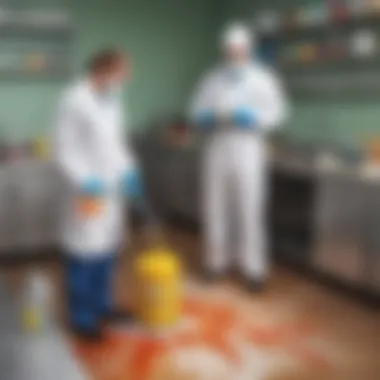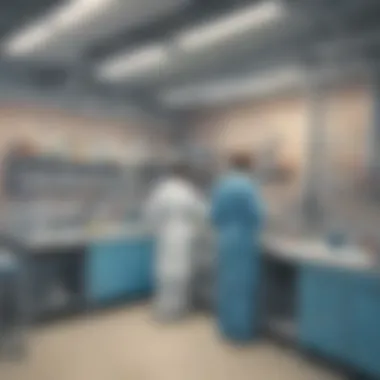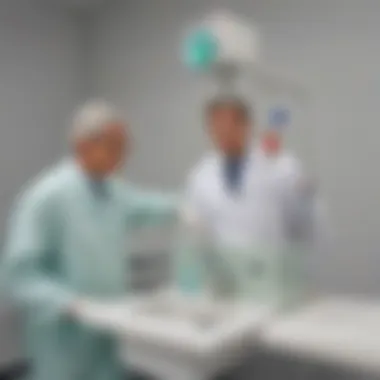Essential Safety Measures for Chemistry Lab Operations: A Complete Guide


Science Fun Facts
Chemistry is astounding 🌟 as it presents a magical world of elements and compounds. Did you know that the element mercury 🪙, liquid at room temperature, is a metal? It's quite perplexing to imagine a fluid metal, isn't it?
Discover the Wonders of Science
Exploring the marvels of chemistry 🧪 can unravel mysteries like why certain reactions fizz and others burst into flames. Let's dive into the secrets of acids and bases through exciting experiments and simulations.
Science Quiz Time
Time for an interactive quiz testing your knowledge of chemical safety precautions! Can you pick the right actions to take in case of a spill? Challenge your scientific acumen now!
Science Experiment Showcase
Get ready for a captivating experiment on chemical safety in the laboratory. With detailed instructions, a materials list, and essential safety tips, you'll be well-equipped to explore the world of chemistry securely.
Preamble
In the expansive realm of scientific exploration, the chemistry laboratory stands as a place of both innovation and inherent risk. The importance of safety precautions in the chemistry lab cannot be overstated, as they serve as the crucial foundation for safeguarding individuals and minimizing the potential hazards that come with experimental work. By adhering to stringent safety protocols, researchers and students alike can create a secure environment that fosters groundbreaking discoveries without compromising well-being.
Safety precautions are not mere suggestions; they are lifelines that protect against the unforeseen. Understanding the relevance of each safety measure ensures a proactive approach to prevent accidents and maintain a safe workspace.
For novice chemists just stepping into the world of laboratory experimentation, comprehending the significance of safety precautions lays a robust foundation for their scientific journey. The cultivation of responsible and safety-conscious practices early on not only guarantees individual well-being but also contributes to a culture of meticulousness and precision within the scientific community.
As we delve into the intricate tapestry of safety protocols within the chemistry lab, we unravel a web of interconnected procedures and guidelines that aim to shield against harm and promote a culture of safety-first principles. Each element within this framework plays a pivotal role in upholding the sanctity of the lab environment and ensuring that chemistry can be pursued with both passion and prudence.
Safety precautions in a chemistry lab play a pivotal role in ensuring the well-being of individuals and maintaining a secure working environment. The significance of adhering to these precautions cannot be overstated, as they serve as the cornerstone of accident prevention and risk mitigation.
Key Elements and Considerations
Chemical Exposure Prevention: Safety precautions are designed to minimize the risk of chemical exposure, which can have detrimental effects on one's health. By following proper guidelines, individuals can significantly reduce the likelihood of accidental spills or inhalation of hazardous substances.
Injury Prevention: The implementation of safety measures aims to prevent injuries that could result from mishandling equipment, improper storage of chemicals, or inadequate use of personal protective gear. Prioritizing safety protocols is crucial for safeguarding against cuts, burns, or other physical harm.
Create Awareness: Understanding the importance of safety precautions fosters a culture of awareness and responsibility among lab personnel. Through education and training initiatives, individuals can grasp the potential hazards present in a lab setting and undertake necessary precautions to avoid accidents.
Legal Compliance: Adherence to safety protocols is not just a best practice but a legal requirement in many jurisdictions. By following established guidelines, labs can comply with regulatory standards, ensuring both the safety of individuals and the integrity of the facility.
Benefits of Upholding Safety Precautions
In the realm of chemistry labs, prioritizing safety precautions offers a multitude of benefits, ranging from personal well-being to operational efficiency.


- Minimized Risks: By implementing safety protocols, labs reduce the likelihood of accidents, thereby minimizing downtime due to injuries or damage to equipment.
- Enhanced Productivity: A safe work environment instills confidence in employees, allowing them to focus on their tasks without concerns about safety hazards. This enhanced focus contributes to overall productivity and quality of work.
- Staff Morale: Maintaining strict safety standards demonstrates an organization's commitment to employee welfare. This, in turn, boosts morale and fosters a positive work culture within the lab.
- Cost Savings: Preventing accidents through safety precautions helps in avoiding costly damages to equipment or potential liabilities arising from injuries. Long-term cost savings are a direct result of diligent safety practices.
General Safety Guidelines
Safety is paramount in a chemistry lab, where handling hazardous materials is routine. Adhering to General Safety Guidelines is imperative to minimize risks and ensure a secure environment for experiments and research. These guidelines encompass a range of precautions that contribute to overall lab safety. Key elements include the proper use of Personal Protective Equipment (PPE), safe handling and storage of chemicals, and emergency procedures.
Personal Protective Equipment (PPE)
In the realm of laboratory safety, Personal Protective Equipment (PPE) plays a pivotal role. This equipment serves as a line of defense against potential hazards, safeguarding individuals from chemical exposure and injuries. When discussing PPE, three critical components come into focus: Wearing Lab Coats, Using Safety Goggles, and Appropriate Footwear. Each element serves a unique purpose in enhancing safety protocols within the lab environment.
Wearing Lab Coats
Wearing Lab Coats is a fundamental aspect of PPE in a chemistry lab. These coats provide a physical barrier between the individual and hazardous substances, preventing direct contact with chemicals and minimizing the risk of contamination. The distinctive feature of lab coats is their full-body coverage, ensuring that clothing underneath remains protected. While lab coats offer significant advantages in terms of safety, they can be restrictive in movement and pose challenges in warmer environments.
Using Safety Goggles
Safety Goggles are essential for eye protection in the lab setting. They shield the eyes from chemical splashes, fumes, and potential projectiles during experiments. The key characteristic of safety goggles is their impact-resistant lenses, which prevent eye injuries caused by flying debris. Although safety goggles are highly effective in safeguarding vision, they can sometimes cause discomfort when worn for extended periods.
Appropriate Footwear
Appropriate Footwear is vital for ensuring overall safety within the lab premises. Proper footwear protects against spills, falls, and sharp objects that may be present on the floor. The key characteristic of suitable lab footwear is its non-slip sole, providing stability and reducing the risk of accidents. While appropriate footwear offers increased protection, it may lack the comfort of regular shoes during prolonged wear.
Handling Chemicals Safely
When it comes to laboratory safety, handling chemicals with care is paramount. Handling Chemicals Safely involves practices such as proper chemical storage, meticulous labeling of containers, and avoiding skin contact. Each of these aspects plays a crucial role in mitigating risks and maintaining a secure lab environment.
Proper Chemical Storage
Proper Chemical Storage is essential for preventing accidents and chemical reactions. Storing chemicals according to compatibility and in designated areas reduces the likelihood of spills and exposure. The primary benefit of proper storage is the prevention of cross-contamination and the promotion of organization, but it requires meticulous labeling and inventory management.
Labeling of Chemical Containers
Labeling of Chemical Containers is a simple yet effective measure to enhance lab safety. Clear and accurate labeling ensures that the contents of each container are known, reducing the risk of misuse or accidental exposure. Properly labeled containers facilitate easy identification and contribute to overall operational efficiency, but adherence to consistent labeling practices is necessary.
Avoiding Skin Contact
Avoiding Skin Contact with hazardous substances is critical to personal safety in a chemistry lab. Skin contact with chemicals can lead to adverse reactions or absorption through the skin, causing harm to individuals. The primary advantage of avoiding skin contact is the prevention of skin irritations or chemical burns, underlining the importance of using protective gear like gloves.
Emergency Procedures
Preparing for emergencies is a crucial aspect of lab safety. Emergency Procedures involve having knowledge of safety equipment locations, protocols for responding to fire incidents, and techniques for dealing with chemical spills. These procedures are designed to ensure a timely and effective response to unexpected situations that may arise in the lab.


Knowledge of Safety Equipment Locations
Familiarity with Safety Equipment Locations is essential for swift action during emergencies. Knowing the precise location of safety showers, fire extinguishers, and first aid kits enables quick access in critical scenarios. The key advantage of this knowledge is the ability to respond promptly to emergencies, but regular drills and training are necessary to maintain preparedness.
Response to Fire Incidents
Response to Fire Incidents demands a calm and methodical approach to ensure the safety of all individuals in the lab. Understanding fire evacuation routes, using fire extinguishers correctly, and alerting authorities promptly are key components of effective response protocols. The primary benefit of a prompt response is the containment of fires, safeguarding lives and preserving valuable research equipment.
Dealing with Chemical Spills
Effectively managing Chemical Spills is vital to prevent accidents and contamination. Proper spill containment, neutralization, and cleanup procedures are essential to minimize the impact of spills on personnel and the environment. The advantage of mastering spill response techniques is the swift resolution of incidents, averting potential hazards and ensuring the continued safety of lab occupants.
Laboratory Equipment Safety
Laboratory equipment safety plays a crucial role in maintaining a secure environment within a chemistry lab. Ensuring proper handling of equipment and instruments not only safeguards individuals but also promotes accurate experimental outcomes. By focusing on preventative measures and meticulous care, the risks of accidents and injuries significantly diminish.
Proper Handling of Glassware
Checking for Cracks or Flaws
Checking for cracks or flaws in glassware is vital to prevent hazardous situations. The slightest imperfection could lead to breakage during experiments, potentially causing spills or injuries. Implementing a thorough inspection process before use reduces the chances of mishaps, thereby enhancing overall lab safety.
Using Tongs or Gloves
Utilizing tongs or gloves when handling glassware offers an additional layer of protection. These tools enable a secure grip on fragile equipment, minimizing the risk of accidental drops or breakage. Their versatility and efficiency make them essential in ensuring delicate maneuvers without compromising safety standards.
Equipment Maintenance
Routine maintenance of lab equipment is imperative for its longevity and accuracy. By conducting regular inspections and calibrating instruments, scientists uphold the integrity of their experiments and data. Preventative maintenance not only reduces downtime but also optimizes the safety and efficiency of laboratory procedures.
Regular Inspections
Regular inspections identify potential issues early on, allowing for timely repairs and replacements. This proactive approach mitigates the chances of equipment failure during critical experiments, ensuring smooth operation and reliable results. Implementing detailed checklists for inspections streamlines the maintenance process, promoting a systematic and thorough examination.
Calibration of Instruments
Calibrating instruments guarantees the precision and reliability of experimental measurements. Accurate readings are essential in scientific research, influencing the validity of findings and conclusions. By calibrating instruments regularly, scientists uphold the standards of quality assurance and data integrity within the laboratory setting.
Chemical Handling Precautions
Chemical handling precautions play a crucial role in ensuring laboratory safety. In the context of this article, focusing on chemical handling precautions is essential as it directly impacts the well-being of individuals working in a chemistry lab. By emphasizing specific elements such as proper storage, labeling, and disposal of chemicals, this section aims to minimize the risk of chemical exposure and accidents. Understanding the benefits of meticulous chemical handling can significantly contribute to fostering a safe and productive work environment where both short-term incidents and long-term health implications are mitigated.


Storage and Disposal of Chemicals
-#### Segregating Incompatible Chemicals: Segregating incompatible chemicals is a critical aspect of chemical handling precautions. By separating chemicals that react dangerously together, the overall risk of chemical reactions causing harm is substantially reduced. This practice is indispensable in maintaining a safe and organized laboratory environment. Highlighting the key characteristic of segregation ensures that substances prone to hazardous interactions are stored apart, thus preventing accidental mixtures. The unique feature of segregating incompatible chemicals lies in its proactive approach to prevent chemical incidents rather than reactively responding to accidents. While the advantages are abundant in terms of safety enhancement, careful attention is required to manage storage areas effectively and maintain detailed inventory.
-#### Adhering to Disposal Guidelines: Adhering to disposal guidelines is paramount in chemical handling precautions. Proper disposal methods ensure that chemicals are eliminated in an environmentally friendly and safe manner, minimizing harm to individuals and ecosystems. By following disposal protocols, the risk of contamination and exposure is significantly decreased, promoting a sustainable laboratory practice. The key characteristic of adherence to disposal guidelines lies in its contribution to overall waste management efficacy within the lab setting. Conforming to prescribed disposal regulations helps prevent pollution and fosters responsible laboratory conduct. The advantage of compliance is the assurance of a cleaner and hazard-free laboratory environment, although meticulous attention is required to strictly follow regulatory directives.
Proper Ventilation
-#### Use of Fume Hoods: The use of fume hoods is instrumental in ensuring proper ventilation within a chemistry lab. Fume hoods act as containment devices, effectively extracting potentially harmful fumes and vapors generated during chemical procedures. This practice not only protects individuals from inhaling toxic substances but also contributes to maintaining air quality in the laboratory. The key characteristic of fume hoods is their ability to create a physical barrier between the chemist and hazardous materials, thus reducing exposure risks. Choosing to utilize fume hoods is a popular choice for laboratory safety measures due to their proven effectiveness in minimizing airborne contaminants. The unique feature of fume hoods lies in their adaptability to varying laboratory setups and the flexibility they provide in ensuring targeted air extraction.
-#### Ventilation Systems Maintenance: Ventilation systems maintenance is indispensable for upholding proper ventilation standards in a chemistry lab. Regular inspection and upkeep of ventilation systems ensure that air circulation remains optimal, mitigating the buildup of hazardous airborne particles. This proactive approach to system maintenance aids in sustaining a safe and healthy working environment for laboratory personnel. The key characteristic of maintaining ventilation systems is the consistency in air quality control, which directly correlates with the well-being of individuals present in the lab. Opting for regular maintenance is a beneficial choice for this article as it underscores the importance of sustained ventilation efficacy in safeguarding against chemical exposure risks. The unique feature of ventilation systems maintenance is its role in preventing system failures and addressing ventilation issues promptly to uphold safety standards.
Personnel Safety Practices
In the realm of chemistry laboratories, Personnel Safety Practices play a pivotal role in maintaining a secure working environment. Ensuring the well-being of everyone involved is paramount to prevent mishaps and guarantee productivity. It encompasses a range of protocols and behaviors adopted to minimize risks and safeguard individuals from potential harm. Personnel Safety Practices serve as the foundation for a culture of safety within the laboratory, emphasizing the significance of adherence to guidelines and regulations.
Practicing Personnel Safety not only protects individuals but also contributes to the overall efficiency of laboratory operations, fostering a conducive atmosphere for scientific endeavors.
Training and Education
Chemical Handling Training
Chemical Handling Training is a crucial component of Personnel Safety Practices. It equips individuals with the necessary knowledge and skills to handle chemicals safely and effectively. The focus lies on recognizing hazardous substances, understanding proper storage procedures, and mastering the art of safe disposal. This training ensures that personnel are well-prepared to mitigate risks associated with chemical exposure and spills, thereby enhancing overall laboratory safety.
Emergency Response Drills
Conducting regular Emergency Response Drills is essential to prepare personnel for unforeseen circumstances. These drills simulate emergency situations such as fires or chemical spills, enabling individuals to practice swift and effective responses. By familiarizing themselves with emergency protocols and procedures, staff members can respond efficiently in real-life emergencies, minimizing potential dangers and maximizing the safety of all involved.
Safe Work Habits
Proper Handwashing
Maintaining proper hand hygiene is a fundamental aspect of Personnel Safety Practices. Regular and thorough handwashing reduces the risk of chemical contamination and transmission of harmful substances. By adhering to proper handwashing techniques, individuals protect themselves from potential hazards and contribute to a hygienic laboratory environment.
Avoiding Food and Drink in Lab
Engaging in facets like handling chemicals while in interacting with consumables such as food or drink is highly risky due to potential contamination, severe safety hazards, and health risks associated with chemicals. This makes the decision to avoid food and drink in lab areas a prudent choice contributing directly to the safety and well-being of all involved in lab operations.
The End
Key Elements Highlighted
In unraveling the myriad facets encapsulating laboratory safety, the Conclusion meticulously encapsulates the key elements reiterated throughout the preceding sections. These elements denote the indispensability of personal protective equipment, the criticality of proper chemical handling, the imperative need for emergency preparedness, the importance of equipment maintenance, and the significance of personnel safety practices.
Benefits and Relevance
The articulation of the Conclusion is not merely a perfunctory summary but a poignant reminder of the overarching benefits and relevance of stringent safety measures within chemistry laboratories. By assiduously adhering to the delineated safety precautions and guidelines, individuals foster a secure working milieu free from potential hazards, thereby mitigating the risks of chemical exposure and injuries. Furthermore, the implementation of thorough safety protocols contributes to cultivating a culture of vigilance and responsibility among laboratory personnel, enhancing overall efficiency and productivity in scientific endeavors.







